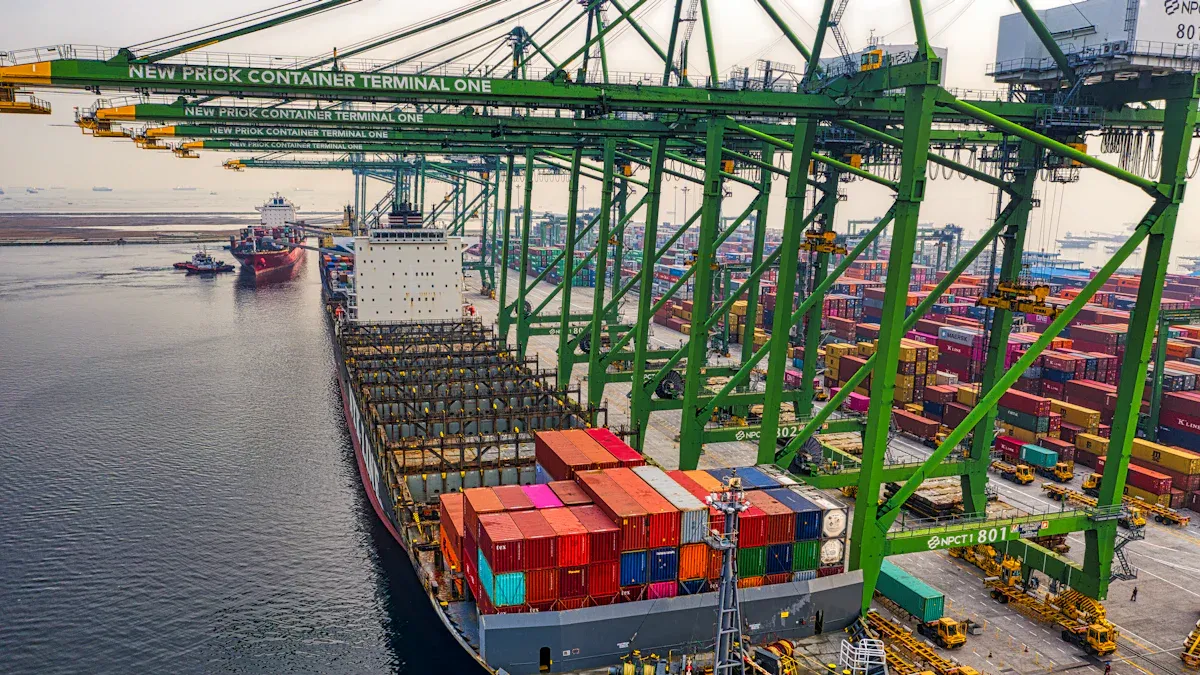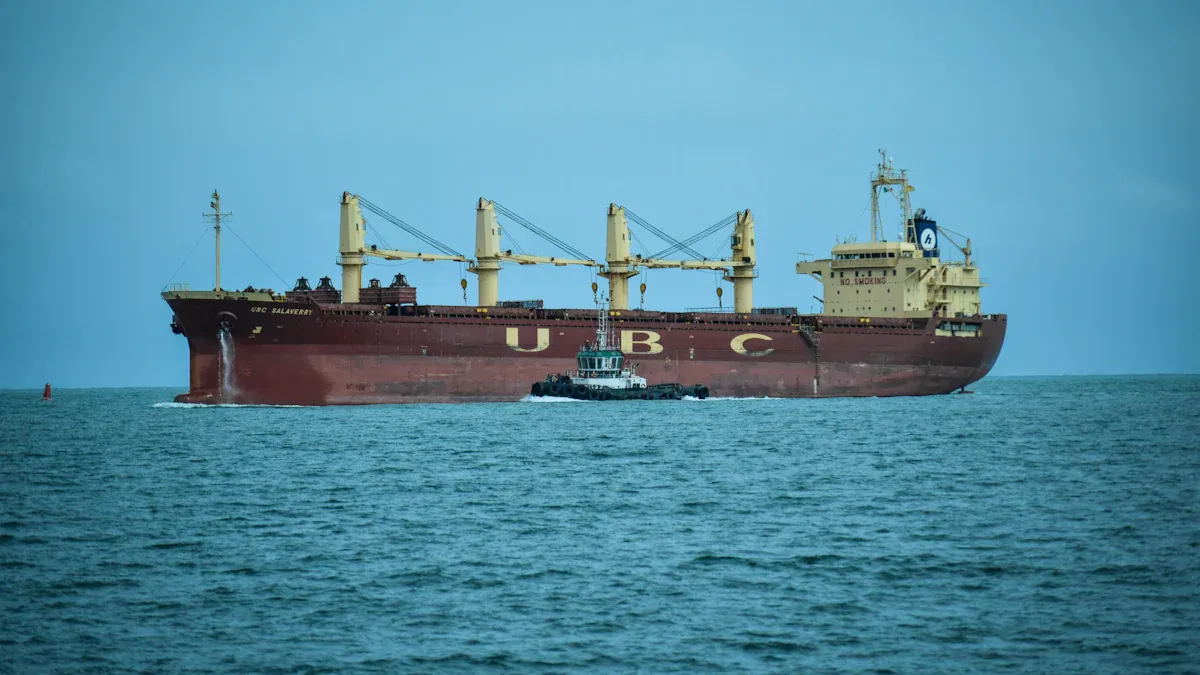Cross-Border Logistics for Mexico

Cross-border logistics plays a pivotal role in supporting trade between Mexico and the United States. In 2023, U.S. freight flows with Canada and Mexico totaled $1.57 trillion, representing 30.8% of all U.S.-international trade. Mexico’s contribution has grown significantly, with the number of commercial trucks entering the U.S. increasing by 62.6% since 2000. Efficient logistics solutions are vital to address the challenges posed by regulatory compliance, freight visibility, and capacity management. JUSDA offers innovative services tailored to this dynamic trade environment, ensuring seamless operations for businesses navigating the U.S.-Mexico market.
Key Takeaways
Moving goods between Mexico and the U.S. is very important, as Mexico's role in trade has grown a lot over time.
Working with a customs broker helps follow rules and clear customs easily, avoiding delays and extra charges.
Having correct paperwork is key for shipping across borders; mistakes can cause big delays and fines.
Picking the right shipping company makes things faster; choose one that knows cross-border work and offers live tracking.
Using technology for live tracking helps businesses see shipments and keep customers happy by reacting quickly to changes.
Mexico's Strategic Role in U.S. Trade
Mexico plays a vital role in U.S. trade due to its proximity and robust manufacturing capabilities. The country has become a hub for industries such as automotive, electronics, and medical devices. The following table highlights key sectors and companies contributing to Mexico's strategic importance:
Sector | Key Companies/Details |
|---|---|
Medical Devices | Over 70 manufacturers in Baja California, including Medtronic, Philips, GE Healthcare. |
Automotive | Tesla's new plant in Santa Catarina; GM, Ford, Volkswagen operations. |
Electronics | Investments from Sony, Samsung, Intel with significant manufacturing plants. |
Aerospace | Hubs in Baja California, Sonora, Querétaro; companies like Bombardier, Honeywell, Airbus. |
These industries benefit from Mexico's skilled workforce, competitive costs, and trade agreements like the USMCA, which streamline cross-border logistics.
Key Players in Cross-Border Logistics
Several companies specialize in cross-border logistics between Mexico and the United States. These organizations provide essential services such as freight forwarding, customs brokerage, and transportation management. The table below lists some of the key players:
Fastfrate Inc. |
Knight-Swift Transportation Holdings Inc. |
Landstar System Inc. |
Ryder System, Inc. |
United Parcel Service of America, Inc. (UPS) |
These companies leverage their expertise to navigate the complexities of cross-border trade, ensuring efficient and reliable logistics solutions for businesses operating in the U.S.-Mexico market.
Key Steps in Cross-Border Shipping

Partnering with a Customs Broker
Partnering with a customs broker is a critical step in cross-border logistics. Customs brokers act as intermediaries, ensuring shipments comply with trade regulations and avoid unnecessary delays. They handle essential tasks such as preparing commercial invoices, certificates of origin, and packing lists. This expertise minimizes errors and ensures smooth customs clearance.
Tip: A high customs compliance rate reflects effective documentation and reduces the risk of penalties or shipment holds.
Customs brokers also provide valuable insights into total landed costs, helping businesses make informed financial decisions. Their role extends to streamlining supply chain processes, which enhances overall efficiency. For instance, brokers often employ legal experts to ensure all documentation is accurate and complete, preventing costly delays.
Metric | Description |
|---|---|
Customs Compliance Rate | The percentage of shipments that comply with customs laws, indicating effective customs paperwork. |
Cost Savings | Customs brokers help identify total landed costs, allowing importers to make informed financial decisions. |
Improved Supply Chain Efficiency | Brokers streamline documentation and compliance processes, reducing delays and enhancing overall efficiency. |
Preparing Essential Documentation
Accurate documentation is the backbone of successful cross-border shipping. Commercial invoices, packing lists, and certificates of origin must be meticulously prepared. Errors in these documents can lead to customs holds, fines, or shipment rejections.
Common challenges include varying paperwork requirements based on shipment specifics. For example, detailed product descriptions and accurate buyer-seller information are essential for customs processing. Preparing documentation ahead of time reduces the likelihood of errors and ensures smoother operations.
Common Errors to Avoid:
Mistakes in commercial invoices.
Inaccurate certificates of origin.
Discrepancies in packing lists.
Note: Even minor discrepancies can delay shipments, emphasizing the importance of attention to detail.
Selecting the Right Freight Provider
Choosing the right freight provider is essential for efficient cross-border logistics. Over 70% of freight crossing the U.S.-Mexico border is transported by truck, making reliable carriers indispensable. The Mexican freight and logistics market is projected to grow significantly, reaching 162.2 billion USD by 2030.
Key factors to consider when selecting a freight provider include their expertise in cross-border operations, network reliability, and compliance with safety standards. Providers with CTPAT certification offer added security, as they follow best practices for mitigating risks.
Tip: Look for providers offering door-to-door visibility, allowing real-time tracking of shipments. This feature ensures transparency and helps address potential delays proactively.
By partnering with experienced freight providers, businesses can optimize their supply chain and capitalize on the growing trade opportunities between Mexico and the United States.
Managing Customs Duties and Taxes
Managing customs duties and taxes is a crucial aspect of cross-border logistics. These charges directly impact the total landed cost of goods, influencing profitability and pricing strategies. Businesses must understand the applicable duty rates and tax percentages to avoid unexpected expenses.
Customs duties vary based on product type, value, and country of origin. For example, cotton T-shirts valued at $1,250 incur a 12% duty rate, resulting in a $150 duty tax. The table below illustrates this calculation:
Product Type | Value | Duty Rate | Duty Tax |
|---|---|---|---|
Cotton T-shirts | $1,250 | 12% | $150 |
Accurate classification of goods under the Harmonized System (HS) Code is essential. Misclassification can lead to penalties or shipment delays. Importers should also stay informed about trade agreements like the USMCA, which may reduce or eliminate duties for qualifying goods.
Tip: Partnering with experienced customs brokers simplifies the process. They ensure compliance with regulations and help businesses identify opportunities for duty savings.
Additionally, businesses must account for value-added tax (VAT) or sales tax, depending on the destination. Proper documentation, including commercial invoices and certificates of origin, ensures smooth customs clearance. By proactively managing these elements, companies can optimize their supply chain and maintain cost efficiency.
Tracking Shipments with JUSDA in North America
Shipment tracking is vital for maintaining visibility and ensuring timely deliveries. JUSDA in North America offers advanced tracking solutions tailored to the U.S.-Mexico market. These tools provide real-time updates, enabling businesses to monitor their shipments from origin to destination.

JUSDA Solutions
To provide you with professional solutions and quotations.
JUSDA's JusLink intelligent supply chain platform integrates IoT, cloud computing, and big data. This technology enhances transparency by offering detailed insights into shipment status, delays, and estimated delivery times. For high-value goods, JUSDA provides independent tracking devices that remain operational even if the cargo separates from the truck.
Note: Real-time tracking minimizes risks and improves decision-making during transit.
JUSDA also prioritizes freight security. Its services comply with CTPAT standards, ensuring that drivers and carriers follow best practices to mitigate risks. This certification reflects JUSDA's commitment to safeguarding shipments and maintaining supply chain integrity.
By leveraging JUSDA's innovative tracking and security solutions, businesses can enhance operational efficiency and build trust with their customers. These capabilities make JUSDA a reliable partner for cross-border logistics in North America.
Challenges and Solutions in Cross-Border Logistics

Overcoming Regulatory Compliance Issues
Navigating regulatory compliance is one of the most significant challenges in cross-border logistics. Businesses must adhere to customs regulations, tax policies, and trade agreements to avoid penalties or delays. Implementing a robust compliance program can simplify this process. For instance, declaring goods in advance improves data quality and risk management. Streamlined customs clearance enhances resource allocation, while certification seals provide recognition for accredited companies. These measures reduce misunderstandings and ensure smoother operations.
Aspect of Compliance Program | Description |
|---|---|
Declaration of goods (DIR) in advance | Allows for better data quality and risk management. |
Streamlined customs clearance | Improves resource allocation and enforcement for non-accredited operators. |
Certification seal | Provides recognition for accredited companies. |
By adopting these strategies, businesses can enhance predictability and efficiency in their cross-border operations.
Addressing Delays at the Border
Delays at the border disrupt supply chains and increase costs. Common causes include customs inspections, documentation errors, and infrastructure limitations. Data from U.S. Customs highlights the impact of these delays on freight movement. For example, the TransBorder Freight Data reveals how international shipments are affected by inspection times.
Dataset Name | Description |
|---|---|
Border Crossing/Entry Data | Provides count information on the number of crossings or entries of people, vehicles, and equipment. |
TransBorder Freight Data | Offers information on international shipments and cargo derived from U.S. international trade statistics. |
Customs Delay Information | Collected by U.S. Customs on delays associated with inspections at various ports. |
To address these issues, businesses can invest in advanced tracking systems and collaborate with customs brokers. These solutions improve visibility and reduce the likelihood of delays.
Ensuring Freight Security and Visibility
Freight security and visibility are critical components of cross-border logistics. Businesses must safeguard shipments against theft and ensure real-time tracking to maintain supply chain integrity. Between 2015 and 2022, Mexico reported 61,806 violent cargo truck thefts, with a 6.7% increase in incidents in 2022 alone. The table below highlights key data on theft incidents:
Year | Incident Count | Notes |
|---|---|---|
2015-2022 | 61,806 | Violent cargo truck thefts in Mexico |
2022 | +6.7% | Increase in theft incidents |
2023 (Jan-Feb) | 237 | Additional theft incidents reported |
Q2 2023 | 57% | Increase in thefts in U.S. and Canada |
Total Loss | $44 million | Estimated loss due to thefts |
To combat these challenges, advanced technologies play a pivotal role. Real-time alerts for shipment anomalies enable businesses to respond quickly to potential threats. Geofencing technology ensures that shipments remain within designated routes, while digital identity verification enhances the security of personnel handling the freight. These measures reduce risks and improve operational efficiency.
Data security also remains a top priority during cross-border operations. Encrypted messages and rule-based security protocols protect sensitive information. These technologies ensure compliance with regulations and maintain the integrity of shared data at border crossings. By adopting these strategies, businesses can enhance both freight security and visibility.
Leveraging JUSDA's Expertise for Risk Management
JUSDA offers unparalleled expertise in managing risks associated with cross-border logistics. Its JusLink intelligent supply chain platform integrates IoT, cloud computing, and big data to provide real-time insights into shipment status. This technology enables businesses to monitor freight movements, detect anomalies, and address potential risks proactively.
JUSDA prioritizes compliance with safety standards, including CTPAT certification. This certification ensures that drivers and carriers follow best practices for mitigating security risks. For high-value shipments, JUSDA employs independent tracking devices that remain operational even if the cargo separates from the truck. These devices provide continuous visibility, enhancing security and reducing the likelihood of theft.
Additionally, JUSDA's focus on risk management extends to regulatory compliance. Its solutions simplify customs processes, ensuring that shipments meet all legal requirements. By leveraging JUSDA's innovative tools and expertise, businesses can navigate the complexities of cross-border logistics with confidence and efficiency.
Optimizing Packaging and Labeling for Compliance
Packaging and labeling play a critical role in ensuring compliance with cross-border logistics regulations. Properly prepared shipments reduce the risk of delays, fines, or rejections at customs. Businesses must adhere to specific requirements for both the U.S. and Mexico, including accurate labeling, clear product descriptions, and compliance with safety standards.
Key considerations for packaging include using durable materials to protect goods during transit. Fragile items require cushioning, while hazardous materials must follow strict guidelines for containment and labeling. Labels should clearly display essential information such as product name, weight, dimensions, and country of origin. Including bilingual labels in English and Spanish can further streamline customs inspections.
Tip: Use standardized barcodes and QR codes on packaging to facilitate faster processing and tracking.
A comparative study highlights the importance of efficient logistics practices, including packaging and labeling, in reducing transit times and costs. The table below illustrates the advantages of intermodal transportation over traditional trucking:
Aspect | Traditional Trucking | Intermodal Transportation |
|---|---|---|
Transit Time | Longer due to border delays | Reduced with pre-clearance |
Cost | Higher due to delays | Lower with minimized wait times |
Cargo Security | Variable | Enhanced through strategic partnerships |
Documentation Requirements | Standard | Same as trucking |
By optimizing packaging and labeling, businesses can enhance cargo security, improve transit efficiency, and ensure compliance with customs regulations. These practices contribute to smoother cross-border operations and cost savings.
Efficient cross-border logistics drives success for businesses operating between Mexico and the U.S. It ensures smooth trade operations, reduces delays, and enhances supply chain efficiency. Partnering with experts like JUSDA provides businesses with tailored solutions to overcome challenges and optimize logistics processes. JUSDA in North America offers advanced tools, such as real-time tracking and risk management, to streamline operations and improve reliability. Businesses seeking to enhance their logistics strategies can explore JUSDA’s innovative solutions to gain a competitive edge in the dynamic U.S.-Mexico trade environment.
FAQ
Why is CTPAT certification important for freight security?
CTPAT certification ensures carriers follow strict security protocols. It reduces risks like theft and ensures compliance with safety standards. Businesses benefit from enhanced freight security and smoother customs processes.
What industries benefit most from JUSDA’s cross-border solutions?
JUSDA serves industries like automotive, electronics, medical devices, and oil and gas. Its tailored solutions address specific challenges, such as hazardous material handling and customs compliance, ensuring efficient logistics for these sectors.
How can businesses reduce costs in cross-border logistics?
Businesses can reduce costs by leveraging trade agreements like the USMCA, accurately classifying goods under HS codes, and optimizing packaging. Partnering with experienced providers like JUSDA also helps streamline operations and minimize expenses.
See Also
Exploring Supplier Dynamics in Global E-commerce Strategies
Achieving Cross-Border Trade Success Through JUSDA Insights
Understanding Current Trends in Logistics Risk Management
Mastering Lean Logistics for Success in Tech Manufacturing
Addressing Global Supply Chain Growth Challenges Effectively
